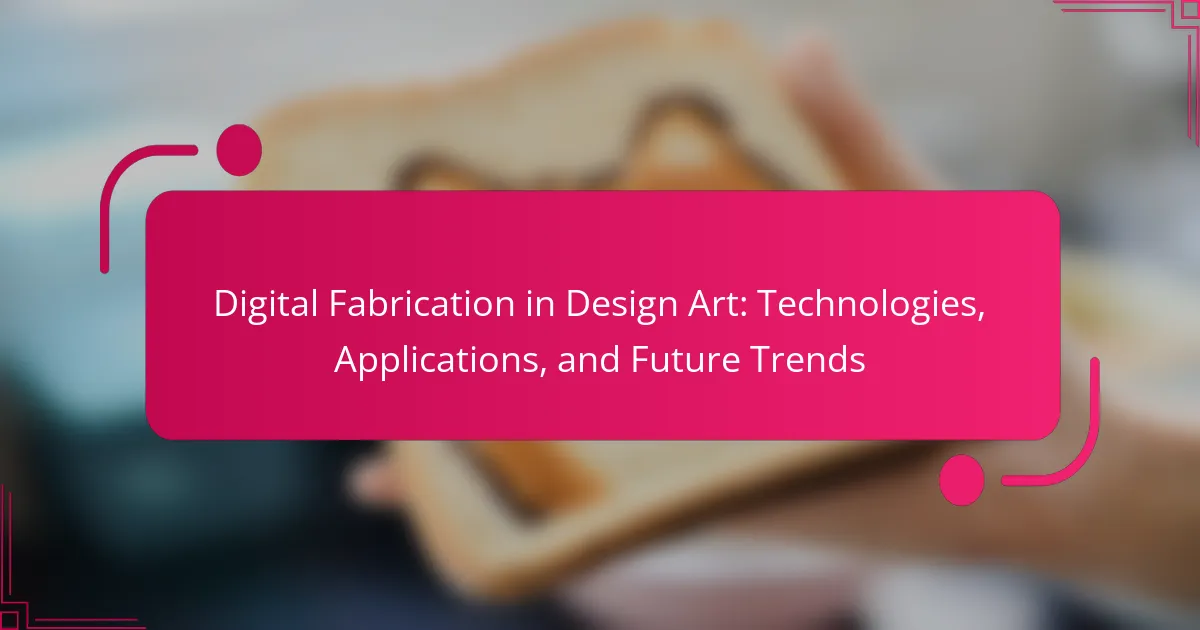Digital fabrication is reshaping the landscape of design art, offering innovative technologies like 3D printing, CNC machining, and laser cutting. These tools enhance creativity and precision while enabling complex designs. The article explores applications of digital fabrication, emerging trends in materials and AI integration, and the challenges artists face in adopting these technologies. Understanding these aspects is crucial for artists aiming to navigate this evolving field effectively.
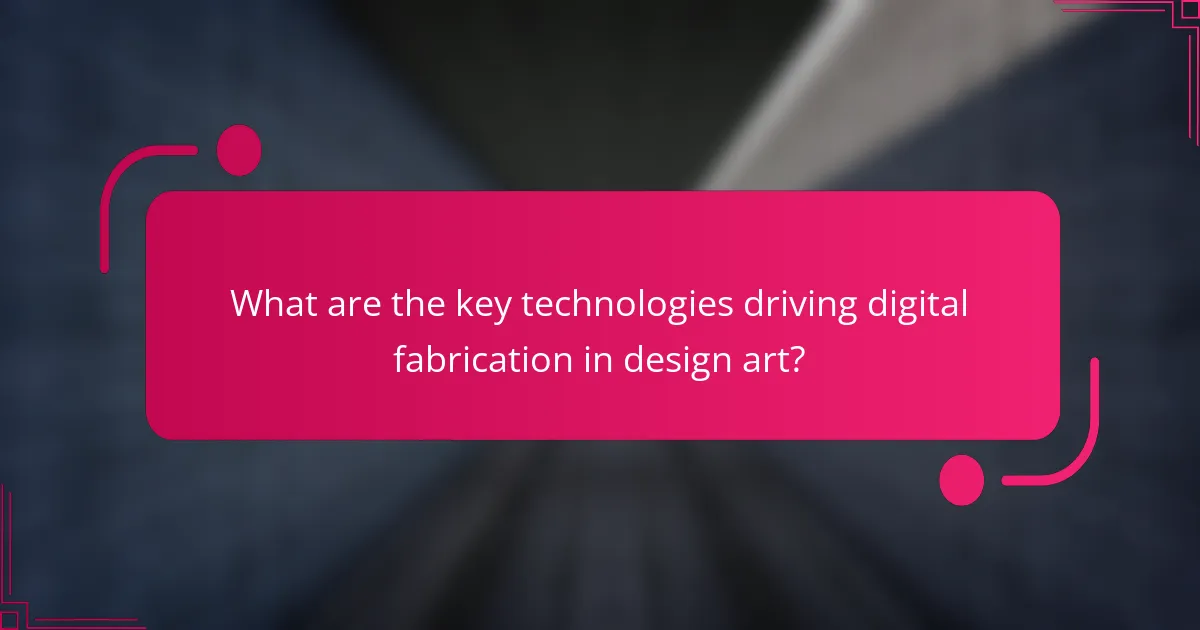
What are the key technologies driving digital fabrication in design art?
Key technologies driving digital fabrication in design art include 3D printing, CNC machining, laser cutting, and digital modeling software. These technologies enhance creative possibilities, allowing artists to produce intricate designs with precision and efficiency.
3D printing enables the creation of complex shapes and structures, utilizing materials like plastics and metals. CNC machining offers a high level of accuracy for sculptural forms and functional art pieces. Laser cutting provides clean edges and intricate detailing, often used in mixed media artworks. Digital modeling software facilitates the design process, allowing for rapid prototyping and visualization.
The future trends in this field involve advancements in materials, such as bio-based and smart materials, and the integration of artificial intelligence to optimize design processes and production methods.
How does 3D printing transform artistic creation?
3D printing revolutionizes artistic creation by enabling artists to produce intricate designs with precision and efficiency. This technology allows for rapid prototyping, reducing the time from concept to finished piece. Artists can experiment with complex geometries that traditional methods cannot achieve, fostering innovation. As a result, 3D printing expands the possibilities of materials used, including biodegradable options and metals, enhancing sustainability in art. The accessibility of 3D printing technology democratizes art-making, allowing more creators to bring their visions to life.
What role does CNC machining play in modern design art?
CNC machining plays a crucial role in modern design art by enabling precision and creativity. This technology allows artists to transform digital designs into tangible objects with intricate details. CNC machines can produce complex shapes and patterns that would be difficult to achieve by hand. As a result, artists can experiment with various materials, enhancing their creative expression. The integration of CNC machining in design art also streamlines production processes, making it easier to replicate and share artistic works. This technology exemplifies the intersection of art and engineering, pushing the boundaries of traditional craftsmanship.
Which software tools are essential for digital fabrication?
Essential software tools for digital fabrication include CAD software, CAM software, 3D modeling programs, and slicing software. These tools facilitate design, manufacturing, and production processes.
1. CAD software: Enables precise design and drafting of 2D and 3D models.
2. CAM software: Converts CAD designs into machine instructions for fabrication.
3. 3D modeling programs: Allows for the creation of complex geometries and designs.
4. Slicing software: Prepares 3D models for printing by generating layers and tool paths.
5. Simulation software: Tests designs virtually to identify potential issues before fabrication.
6. CNC control software: Manages CNC machines for accurate and automated production.
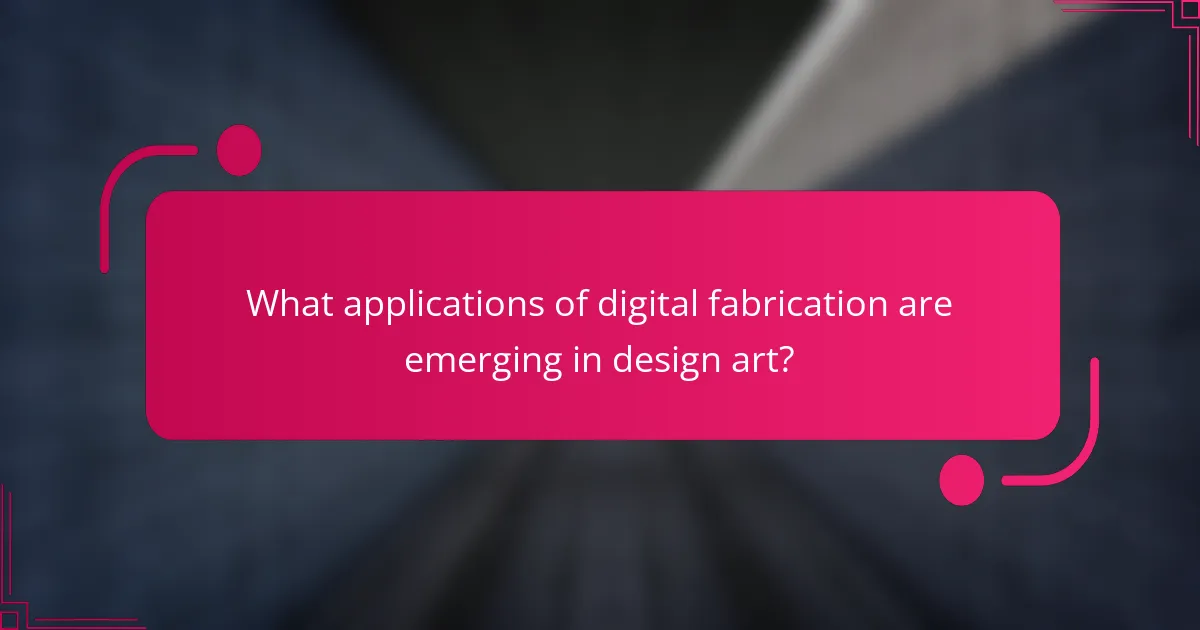
What applications of digital fabrication are emerging in design art?
Digital fabrication is revolutionizing design art through innovative applications. Emerging uses include 3D printing for custom sculptures, CNC machining for intricate patterns, and laser cutting for precise designs. These technologies enable artists to create complex forms that were previously unattainable. As a result, digital fabrication fosters unique artistic expressions and enhances collaboration between artists and engineers.
How is digital fabrication influencing sculpture and installation art?
Digital fabrication significantly impacts sculpture and installation art by enabling innovative designs and precise production methods. Artists utilize technologies like 3D printing and CNC machining to create complex forms that were previously unachievable. These tools enhance creativity, allowing for intricate details and customization at scale. As a result, digital fabrication expands the possibilities for material use, including plastics and metals, while also streamlining the production process. This evolution in art-making fosters new collaborations between artists and technologists, shaping future trends in the art world.
What are the implications of digital fabrication in textile design?
Digital fabrication significantly transforms textile design by enhancing customization and efficiency. It enables designers to create intricate patterns and structures, leading to innovative products. Technologies like 3D printing and laser cutting streamline production, reduce waste, and allow for rapid prototyping. As a result, designers can experiment with materials and designs that were previously impractical, fostering creativity and sustainability in the industry. The future of textile design will increasingly rely on these digital fabrication techniques, shaping trends and consumer expectations.
How do artists leverage digital fabrication for interactive installations?
Artists leverage digital fabrication for interactive installations by utilizing technologies such as 3D printing, laser cutting, and CNC machining. These methods enable precise, customizable designs that enhance viewer engagement. Interactive installations often incorporate sensors and software that respond to audience interaction, creating dynamic experiences. The ability to produce complex forms and integrate various materials allows artists to explore new creative possibilities, pushing the boundaries of traditional art forms. As digital fabrication continues to evolve, artists increasingly adopt these techniques to create immersive environments that foster dialogue and interaction.

What challenges do artists face when adopting digital fabrication?
Artists face several challenges when adopting digital fabrication, including high costs, technical skills gaps, and material limitations. These obstacles can hinder the creative process and access to technology. High initial investments in equipment and software can be a barrier for emerging artists. Additionally, mastering complex software and machinery requires time and training, which may not be readily available. Limited access to suitable materials can further restrict the types of projects artists can undertake, impacting their creative expression.
What are the common technical limitations of digital fabrication?
Digital fabrication faces several common technical limitations. These include material constraints, precision issues, software compatibility, and scalability challenges.
Material constraints limit the types of materials that can be used effectively, often restricting creativity. Precision issues can lead to inaccuracies in the final product, affecting quality and functionality. Software compatibility can hinder the integration of different systems, complicating workflows. Scalability challenges arise when attempting to produce larger quantities or sizes, impacting efficiency and cost-effectiveness.
How do cost and accessibility affect the use of digital fabrication?
Cost and accessibility significantly influence the adoption of digital fabrication technologies in design art. High costs can limit access to advanced tools, while affordable options increase participation. Accessibility also includes the availability of training and resources, which affects user proficiency. As a result, equitable access can drive innovation and diversity in design applications.
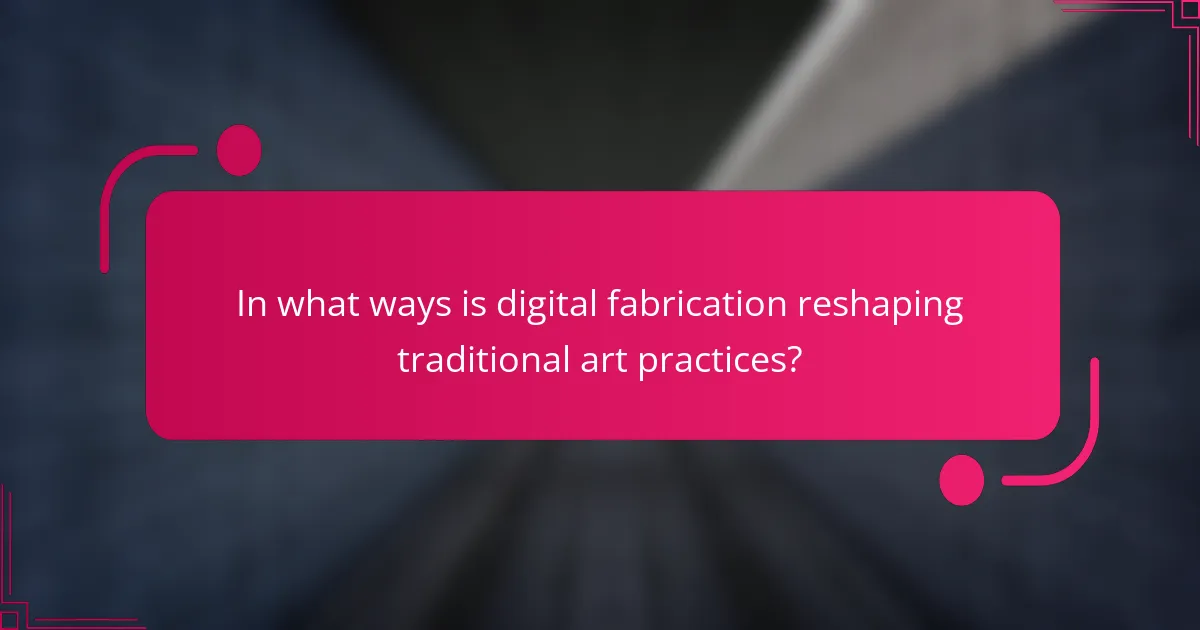
In what ways is digital fabrication reshaping traditional art practices?
Digital fabrication is transforming traditional art practices by enabling new methods of creation and interaction. Artists now utilize technologies such as 3D printing, laser cutting, and CNC machining to produce intricate designs that were previously unattainable. This shift allows for greater precision and customization, enhancing artistic expression.
Moreover, digital fabrication fosters collaboration between artists and technologists, leading to innovative interdisciplinary projects. Artists can experiment with materials and techniques, resulting in unique artworks that challenge conventional boundaries. As a result, the integration of digital fabrication in art is not merely a trend but a fundamental change in how art is conceived and produced.
Future trends indicate a growing reliance on digital tools, further blurring the lines between traditional craftsmanship and modern technology. This evolution encourages a redefinition of artistic identity and the role of the artist in the creative process.
How does digital fabrication enable new forms of collaboration among artists?
Digital fabrication fosters collaboration among artists by providing innovative tools and platforms for creative expression. Technologies like 3D printing and CNC machining enable artists to share designs and collaborate remotely, breaking traditional barriers. As a result, artists can experiment with new materials and techniques, enhancing their collective creativity. This collaborative approach leads to unique art forms that reflect diverse perspectives and skills, showcasing the power of technology in artistic collaboration.
What cultural shifts are prompted by the integration of technology in art?
The integration of technology in art prompts significant cultural shifts, including enhanced accessibility and new forms of expression. Digital fabrication allows artists to create intricate designs that were previously unattainable. As a result, diverse voices can emerge, democratizing the art world. The fusion of technology and art fosters collaboration across disciplines, leading to innovative projects that challenge traditional boundaries. Furthermore, this shift influences audience engagement, as interactive and immersive experiences become more prevalent.
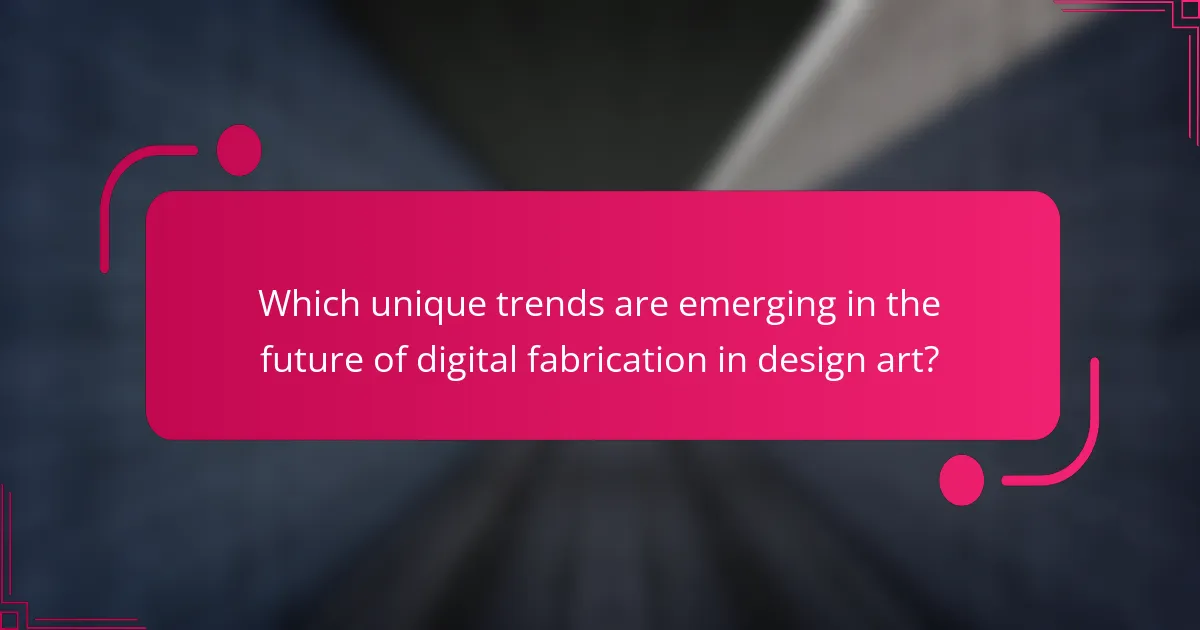
Which unique trends are emerging in the future of digital fabrication in design art?
Emerging trends in digital fabrication for design art include increased use of AI-driven design tools, sustainable materials, and personalized production methods. These innovations enhance creativity and efficiency while meeting contemporary demands for sustainability.
The integration of AI enables designers to explore complex geometries and optimize designs for performance. Sustainable materials, such as bio-based plastics and recycled composites, reduce environmental impact. Personalized production methods allow for unique, custom pieces that cater to individual preferences.
Additionally, advancements in 3D printing technologies are expanding possibilities in sculptural art and architecture. These trends indicate a shift toward more adaptive and environmentally conscious practices in design art.
What innovations are expected in materials used for digital fabrication?
Innovations in materials for digital fabrication are expected to enhance performance and sustainability. Key advancements include bio-based polymers, which reduce environmental impact, and smart materials that adapt properties in real-time. Additionally, advancements in metal alloys will improve strength and reduce weight, while nanomaterials will enable finer resolutions in printing. These innovations are driving the future of design art, making processes more efficient and versatile.
How might sustainability influence the future of digital fabrication?
Sustainability will significantly shape the future of digital fabrication by promoting eco-friendly materials and processes. As designers prioritize reducing waste, techniques such as additive manufacturing will gain traction. This shift will encourage innovation in biodegradable materials, enhancing the environmental impact of design art. Moreover, sustainable practices will drive collaboration among industries, fostering advancements in energy-efficient technologies.
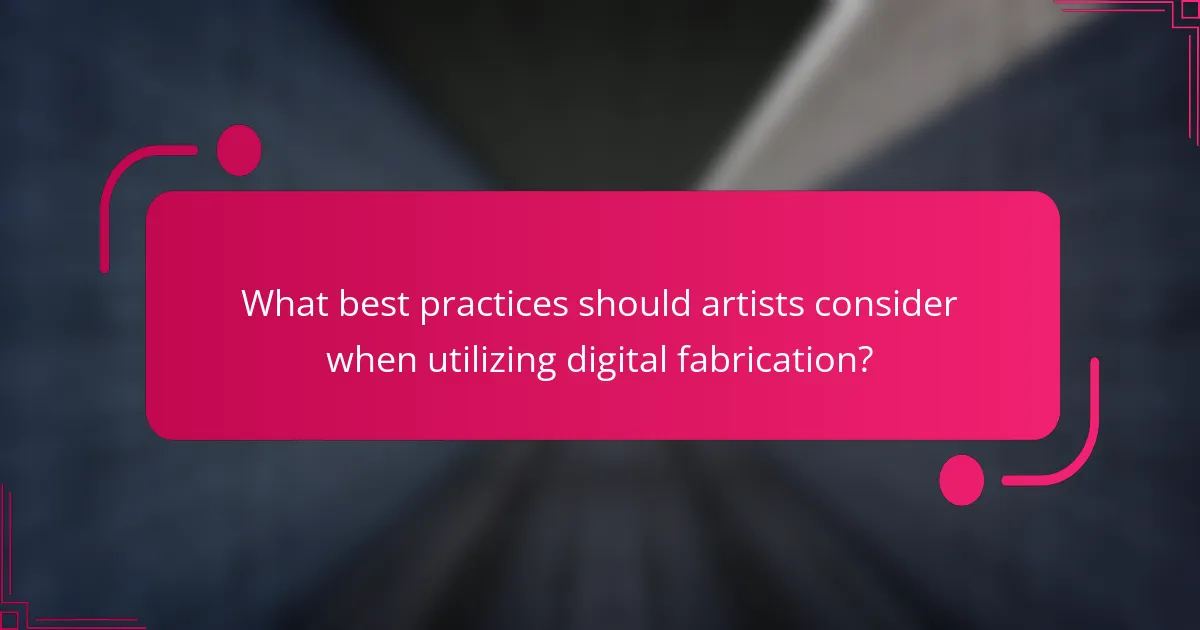
What best practices should artists consider when utilizing digital fabrication?
Artists should prioritize planning, material selection, and equipment mastery when utilizing digital fabrication. Effective project planning ensures efficient workflow and resource management. Choosing appropriate materials enhances the final output’s quality and durability. Mastering equipment allows artists to maximize the technology’s potential, leading to innovative designs. Collaborating with other professionals can also provide valuable insights and broaden creative possibilities. Finally, staying updated on industry trends helps artists remain competitive and inspired.
How can artists optimize their workflow with digital fabrication tools?
Artists can optimize their workflow with digital fabrication tools by integrating advanced technologies that enhance precision and efficiency. These tools, such as 3D printers and CNC machines, allow for rapid prototyping and customization, enabling artists to realize their creative visions more effectively.
Utilizing software that connects design and fabrication processes streamlines project management, reducing errors and saving time. Additionally, adopting collaborative platforms fosters communication among artists and manufacturers, ensuring alignment on project goals.
Emerging trends in digital fabrication, like sustainable materials and AI-driven design, further enhance creative possibilities. As a result, artists can explore innovative techniques while minimizing waste and environmental impact.
What are the common mistakes to avoid in digital fabrication projects?
Common mistakes to avoid in digital fabrication projects include inadequate planning, neglecting material properties, and failing to test prototypes. These errors can lead to wasted resources and unsatisfactory outcomes.
1. Inadequate Planning: Skipping detailed designs and timelines can result in unforeseen challenges.
2. Neglecting Material Properties: Using inappropriate materials can compromise functionality and aesthetics.
3. Ignoring Software Compatibility: Failing to ensure that design software matches fabrication tools can cause errors.
4. Overlooking Safety Protocols: Not adhering to safety measures can lead to accidents and injuries.
5. Insufficient Testing: Not prototyping can lead to design flaws that are costly to fix later.
